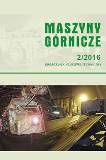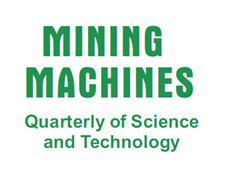KOMAG Institute of Mining Technology
MISSION
Innovative solutions for economy.
VISION
Design
Designing of machines and equipment
Tests
Laboratory of Applied Tests
Certification
Assessment of products' conformity
Projects
Projects realized by the KOMAG Institute from European Funds
 |
A scientific-and-technical quarterly, published by the KOMAG Institute of Mining Technology for over 30 years, is a magazine which presents scientific, research-and-development and implementation projects in the domain of mining mechanization, especially as regards the following:
|
Articles written by scientists from institutes and universities, employees from research-and-development centres as well as mine technical personnel and manufacturers of machines are presented in the quarterly.
Contact
Phone:
Managing Editor 48 32 2374 177
E-mail:
This email address is being protected from spambots. You need JavaScript enabled to view it., This email address is being protected from spambots. You need JavaScript enabled to view it.
BALAWENDER A., ŚLIWIŃSKI P.
Adaptive control of the electro-hydraulic drive in changeable load conditions
DINDORF R., WOŚ P., WOŁKOW J.
Studies on the sealing nods in transitory states of the machine mechanisms
GAWRYŚ E, KOLLEK W., KUDŹMA Z., PALCZAK E.
Influence of working fluid viscosity on the change of the operational parameters range of hydraulic engine and on energetic efficiency of the system with proportional control
PASZOTA Z.
Testing the hydraulic executing components in the powered roof support unit in the aspect of European Union requirements
MADEJCZYK W.
Active path of the beater extension in a percussive mechanisms of the hydraulic WOU-42SM rotary-and-percussive drill
KALUKIEWICZ A, NIEŚPIAŁOWSKI K., WARACHIM W.
Hydraulic cylinder – a machine or pressure installation in the light of European directives
GAWOL J., KACZMARCZYK J.
Scientific-and-technical information as the supporting component in the knowledge management
ZAJĄC R.
Test rig, methodology and testing the hydraulic engines supplied with water-oil emulsion
BALAWENDER A., ŚLIWIŃSKI P.
S u m m a r y
A new test rig designed and constructed at the Hydraulics and Pneumatics Department of the Gdańsk Technical University to study hydraulic engines supplied with water-oil emulsion was described. The testing methodology as well as test results of a new satellite hydraulic engine of the HS type designed, among others, to be used in the mining industry was given. A comparison of results obtained from the tests with an engine supplied with water-oil emulsion was performed.
Adaptive control of the electro-hydraulic drive in changeable load conditions
DINDORF R., WOŚ P., WOŁKOW J.
S u m m a r y
An idea of the adaptive controller used in the control system of the electro-hydraulic drive operating in changeable load conditions was presented. An analysis of the PID adaptive controller was performed by a determination of its parameters, basing on the parameters of the model. A simulation of the adaptive controller using an identification with the recurentive least squares (RLS) method with compensation system was given.
Studies on the sealing nods in transitory states of the machine mechanisms
GAWRYŚ E, KOLLEK W., KUDŹMA Z., PALCZAK E.
S u m m a r y
The results of studies on sealing nods in the hydraulic rams of the machine mechanisms were given. Some of the durability tests in the ram prototypes as well as their behaviour in the machine mechanisms transitory states were presented.
Influence of working fluid viscosity on the change of the operational parameters range of hydraulic engine and on energetic efficiency of the system with proportional control
PASZOTA Z.
S u m m a r y
The influence of working fluid (a hydraulic oil) viscosity, determined by a simulation, on “ki” and “a” factors, which characterize the hydraulic system components, was presented. The “ki” loss factors, which change their values with the change of oil viscosity , influence the energetic efficiency η for the specified speed facto and engine load factor . From the other side the “ki” factors influence the amount of the system’s operational area, determined by the range of factors and change, and in the result they influence a maximal value of the ηmax system efficiency, possible to be achieved. That was shown on an example of the system with a proportional control, where the throttling separator is supplied with a pump of the constant output, operating with the overflow valve.
Testing the hydraulic executing components in the powered roof support unit in the aspect of European Union requirements
MADEJCZYK W.
S u m m a r y
The requirements which the hydraulic executing components in the powered roof support unit should meet from the day of 1st of May, were presented. The Polish Standards PN-EN 1804-1:2202(U) and PN-EN 1804-2:2202(U) have a status of standards harmonized with the 98/37/EC Machine Directive being in force in European Union.
Active path of the beater extension in a percussive mechanisms of the hydraulic WOU-42SM rotary-and-percussive drill
KALUKIEWICZ A, NIEŚPIAŁOWSKI K., WARACHIM W.
S u m m a r y
Conditions of the hydraulic impact occurrence in a percussive mechanism of the hydraulic WOU-42SM rotary-and-percussive drill were presented. The amount of hydraulic impact in relation to the beater stroke was determined on the basis of the performed studies and its relationship with a total beater impact force was determined as well.
Hydraulic cylinder – a machine or pressure installation in the light of European directives
GAWOL J., KACZMARCZYK J.
S u m m a r y
The bill about a conformity assessment system obliges the producers to make a conformity assessment of products before their commercialization. The conformity assessment process requires to carry out the analyses of records included in the general and detail requirements. The procedure which should be followed in conformity assessment, interpretation difficulties of requirements as well as participation of notified bodies in that process were described.
Scientific-and-technical information as the supporting component in the knowledge management
ZAJĄC R.
S u m m a r y
Information is the knowledge indispensable for a realization of tasks needed to the institutions to reach specified objectives. Information means a documentation, data, news having a great significance, a their proper circulation is a condition of an effective management. Recently it was stated that information management is a vital part of organizational management. In the environment where technologies and methodologies become out-of-date, a men faces the necessity of possessing detailed, actual and complete data indispensable for taking rational decisions. The present paper focuses only on scientific-and-technical information, which is only a small part of knowledge and information management.
PENAR Z.
Work safety during longwall shearers operation
MAZUR M.
Development of the longwall shearers designs for Polish and foreign customers
KOSTEMPSKI M., SKRZYPIEC A.
Experience from an operation of the KSW-1140E longwall shearers with an electric drive supplied with 3.3 kV voltage, manufactured by the Zabrzanskie Mechanical Works JSC
GIL E., GASZKA J.
Technical and economical factors which determine the use of production potential of the longwall face
JASZCZUK M.
Influence of the rock cutting speed on the cutting bits life
JONAK J.
Worm cutting drums equipped with disk tools
KRAUZE K.
High energy impact on powered roof supports
SIKORA W.
Impact load identification
HOLNICKI-SZULC J., WIKŁO M.
Trial of identification of dynamic rock mass impact on powered roof supports using Finite Elements (FEM) and Finite Difference (FDM) Methods
KWAŚNIEWSKI M., WINKLER T. SZYGUŁA M., TOKARCZYK J.
Concept of the powered roof support adapted for operation in the rock mass tremor hazard conditions
SZYGUŁA M., MAZUREK K., HOLNICKI-SZULC J., MRÓZ A.
Possibilities and results of suppression of the kinetic energy impulse, transferred to the lemniscate support unit by surrounding rock before the relief valve start to operate
PTAK J., LOSIAK S.
New generation ploughs for the seams of small and medium thickness
PASCHEDAG U., BURZAN K., JUSCZYK H.
KOMAG Mining Mechanization Centre – Notified Body No 1456
MEDER A., GAWOL J., KACZMARCZYK J.
Hundred editions of “Mining Machines” magazine are the presentation of development of the Polish mining industry mechanization
PENAR Z.
S u m m a r y
The genesis of establishment and development of the technical magazine entitled “Mining Machines” edited by KOMAG Centre, the R & D organization, was pre- sented. Changes and reorganization of the technical and scientific base in the mining industry were dis- cussed. The changes concerned both the problems discussed in printed articles, its essential content as well as the graphic appearance and the content of editors board.
Work safety during longwall shearers operation
MAZUR M.
S u m m a r y
The present legal status as well as the safety regu- lations in the mining plants for using longwall shearers were presented. Hazards which may occur during longwall shearers operation were discussed including the safety conditions in mining plants as regards longwall shearers operation.
Development of the longwall shearers designs for Polish and foreign customers
KOSTEMPSKI M., SKRZYPIEC A.
S u m m a r y
The whole longwall shearers development process beginning from the shearers with hydraulic haulage drive to the shearers with electric haulage drive with frequency transformer installed on the machine was discussed.
Experience from an operation of the KSW-1140E longwall shearers with an electric drive supplied with 3.3 kV voltage, manufactured by the Zabrzanskie Mechanical Works JSC
GIL E., GASZKA J.
S u m m a r y
The experience from an operation of the KSW-1140E longwall shearer with an electric drive, supplied with 3.3 kV, manufactured by Zabrzanskie Mechanical Works S.A. was presented. The shearers of the KSW 1140E type, used in “Wesola” Colliery, meet the mine’s expectations and guarantee the production on the accepted level, after elimination of failures occurring in the first period of operation. Technical solutions used in the mechanical and electrical parts make a design of the shearer very successful.
Technical and economical factors which determine the use of production potential of the longwall face
JASZCZUK M.
S u m m a r y
Factors that influence the use of technical potential of longwall shearers, associated with its proper selection to the given natural conditions of the face, techno- logical process in the face as well as to the availability of machines and equipment that make a technological line face – shaft tank, were analyzed. An impact ot the mechanical system availability on the production rate was given on an example of the face equipped with the KSW/E-620 shearer. The readiness factor of the shearer and other components of longwall system was presented. The factors which determine the use of a theoretical shearer’s output were given on an example of KSW-500 shearer operational tests. The efficiency factor of technology, which determines a degree of the face production potential usage was discussed.
Influence of the rock cutting speed on the cutting bits life
JONAK J.
S u m m a r y
Problems associated with the cutting bits wear as regards the cutting speed as well as an impact of some rock properties on the process were discussed in relation to the cutting drums designing process.
Worm cutting drums equipped with disk tools
KRAUZE K.
S u m m a r y
Repeated interesting of Polish hard coal mines in disk tools caused a development of the prototype design of worm cutting drums equipped with disks by Processing and Transportation Mining Machines Department of AGH and Zabrzanskie Mechanical Works S.A. Designs of the cutting drums of that design for coal and hard coal interlayer cutting were presented on the background of existing designs. Special attention was paid to a discussion of advantages and disadvantages of disk tools in comparison to the presently used cutting bits.
High energy impact on powered roof supports
SIKORA W.
S u m m a r y
Tasks of the roof support in longwall faces and types of dynamic phenomena in the mining industry as well as factors influencing bumps were presented. A use of powered roof support has the significant impact on bumps reduction in face as it improves supporting of the roof, reduces the bump hazard in the face and moving the hazard from longwall face to the near-longwall roadways. The roof support can also reduce bump effects due to a special design.
Impact load identification
HOLNICKI-SZULC J., WIKŁO M.
S u m m a r y
Further development of methodology for identification of load’s scenario formulated in Ref.10 (including non-linear effects due to local damages), causing measured structural deformations is presented. The intelligent sensor system monitoring load scenario and the corresponding damage (plastic yield, buckling and/or brittle crack) development can play the role of a black box allowing an after-accident-diagnosis.
Trial of identification of dynamic rock mass impact on powered roof supports using Finite Elements (FEM) and Finite Difference (FDM) Methods
KWAŚNIEWSKI M., WINKLER T. SZYGUŁA M., TOKARCZYK J.
S u m m a r y
In this paper we have presented a way of dynamic modelling of rock mass impact on supporting structures with the use of finite different and finite element methods. The finite difference method has been used to construct a numerical, laminar-block rock mass model. In this model we have simulated coal seam mining with caving in roof layers and a rock mass tremor. The results of computations (the distribution of roof vibration velocity) have been used, using finite element method, to dynamically load the canopy of powered roof support.
Concept of the powered roof support adapted for operation in the rock mass tremor hazard conditions
SZYGUŁA M., MAZUREK K., HOLNICKI-SZULC J., MRÓZ A.
S u m m a r y
Aconception of powered roof support adapted for operation in bumping condition was discussed. New solutions that can eliminate disadvantages of the analyzed solutions were presented. These are the novelty solutions.
Possibilities and results of suppression of the kinetic energy impulse, transferred to the lemniscate support unit by surrounding rock before the relief valve start to operate
PTAK J., LOSIAK S.
S u m m a r y
The paper concerns the possibility of suppression of the kinetic energy, transferred by the lemniscate support unit by surrounding rocks, at the first stage of legs operation. It gives a condition of the kinetic energy suppression and equations for the support system operation. It results, from the equations, what kind of design and roadway parameters influence the support system operation which can suppress a kinetic energy transferred to the unit as an impulse. Given relationships were illustrated by exemplary calculations which represent the effects of the partial suppression of energy impulse.
New generation ploughs for the seams of small and medium thickness
PASCHEDAG U., BURZAN K., JUSCZYK H.
S u m m a r y
Present plough technique, currently used by DBT, was presented. The methods for designing and planning the plough faces were specified. The criteria for a selection of shield support as well as a control and automatics systems were discussed. The reference examples of use of ploughs of a new generation were given.
KOMAG Mining Mechanization Centre – Notified Body No 1456
MEDER A., GAWOL J., KACZMARCZYK J.
S u m m a r y
The Conformity Assessment System’s Bill specifies the organizations which participate in the process of the product assessment before its commercialization. The process of reaching the notified body No 1456 status by the KOMAG Mining Mechanization Centre was discussed as well as authorizations and procedures resulting from that notification.
S. CIERPISZ
Possibilities of increasing an efficiency of control coal beneficiation process in pulsating jigs of KOMAG type
D. KOWOL, M. LENARTOWICZ, M. OSOBA,
New generation of pulsating jigs of the KOMAG type for gravel and sand winning
M. OSOBA, A, LUTYŃSKI
DISA 3/2KR-2600/2000 two-functional suspension separator as the device for direct three-product or two-product beneficiation
S. SOREK
Dynamic impact of super resonance screens on the supporting construction
T. BANASZEWSKI, A. FILIPOWICZ
Identification of dynamic load of vibrating feeder for the FEM strength analysis
T. WINKLER, M. OSOBA, S. BOJARA, W. CHUCHNOWSKI, J. TOKARCZYK
Vibrating screen – continuous process of searching for optimal solutions
Z. ŚMIEJEK
Municipal wastes segregation by dry methods
P. WODZIŃSKI
Procedures with wastes generated in processing plants in the light of the environmental protection requirements
D. KASPRZAK, B. GRYNKIEWICZ-BYLINA
Product safety and responsible for the product in European legal system
Romana ZAJĄC,
Coal quality monitoring and control during its beneficiation
S. CIERPISZ
S u m m a r y
Use of instrumental methods of measurements of ash and water content as well as coal caloric value in systems for monitoring and control the quality parameters of coal products was presented. Examples of systems for stabilization of ash content and maximization of coal production were given. Systems of single jigs as well as simple and complex technological systems were discussed. Special attention was paid for optimization of production of steam coal mixtures using an automatic quality control system.
Possibilities of increasing an efficiency of control coal beneficiation process in pulsating jigs of KOMAG type
D. KOWOL, M. LENARTOWICZ, M. OSOBA,
S u m m a r y
Selected R & D projects, realized in Processing Systems Division at the KOMAG Centre, on an efficiency of raw coal beneficiation processes in pulsating jigs of the KOMAG type, were discussed. Test results of influence of measurement float shape of the separation layer on beneficiation products offtake stabilization and intensification of heavy product offtake through the channel slits using impeding baffles, were presented.
New generation of pulsating jigs of the KOMAG type for gravel and sand winning
M. OSOBA, A, LUTYŃSKI
S u m m a r y
Many years of KOMAG experience in jigs designing and selection, enable to use them in aggregate industry, especially for gravel and sand winning with the separation of organic impurities. Technological studies of gravel and sand separation, conducted in laboratory conditions on a test stand and industrial studies carried out in selected mines which use technological systems based on beneficiation of raw coal in pulsating washery jigs, confirmed a purposefulness of use the designs proved in hard coal processing for gravel and sand production. The new generation of a jig of the KOMAG type (pulsating classifier) operating in aggregate mine in industrial condition was presented.
DISA 3/2KR-2600/2000 two-functional suspension separator as the device for direct three-product or two-product beneficiation
S. SOREK
S u m m a r y
The process of modernization and adaptation of jigs design to the requirements associated with Mining Plant modernization aimed at adaptation to new technological requirements was presented. A design description, which enabled to follow the change sequence made till the development of a new jig of significantly extended possibilities due to its modular construction, was presented. An example of installation of the DISA 3/2KR-2600/2000 two-functional suspension separator in the coal processing plant at “Pniówek” Colliery was given.
Dynamic impact of super resonance screens on the supporting construction
T. BANASZEWSKI, A. FILIPOWICZ
S u m m a r y
Dynamic impact of super resonance screens on a direction parallel to the steel, screw-and-cylinder spring was described in details. The amounts of impact can be determined by the commonly used formulae. Lack of simple functions, describing a horizontal impact of the screen, results from not explicit description of transverse rigidity of the springs. A survey of methods used to describe the elasticity factor of cylinder steel springs on a direction perpendicular to their axes was presented in the paper. The simplest empiric formula describing the transverse rigidity basing on the spring longitudinal rigidity had been selected from the suggested methods. That formula was used for calculations of elasticity value on the direction perpendicular to spring axes in ten or so screens. The measurement of transverse spring rigidity was conducted to verify the formula. The measured value differed from calculation results by about 9%.
Identification of dynamic load of vibrating feeder for the FEM strength analysis
T. WINKLER, M. OSOBA, S. BOJARA, W. CHUCHNOWSKI, J. TOKARCZYK
S u m m a r y
The method for dynamic and strength calculations of the WPR 1,3x4,5 vibrating feeder was presented. The correctness of accepted design requirements was the aim of the numeric calculations. The feeder design was modified in a result of conducted analyses.
Vibrating screen – continuous process of searching for optimal solutions
Z. ŚMIEJEK
S u m m a r y
The screen is one of the main technological machine in all installation for minerals processing. Role and tasks of the screen is are decisive for the whole process and often it decides about beneficiation results, that is why so mach attention is paid to its design and operation. That machine undergoes the process of continuous improvement of technical and technological parameters. The design proposal, presented in the article, relates to theoretical grounds and has been compared with the solutions of similar functions used in the Polish mineral processing plants. The screen having a broken deck line, set to vibration move by the single inertial drive, realizes a dry classification process with circle-and-elliptical trajectory, according to the rule of “angles of slide” and with acceleration. of 5g The machine is a very important component of the washery jig installation, which can improve the processing products quality and first of all it enables to reduce operational costs. KOPEX S.A. with a co-operation of other companies plans to carry out the classification process by using this machine in Polish and foreign processing plants.
Municipal wastes segregation by dry methods
P. WODZIŃSKI
S u m m a r y
Wastes segregation is the problem which arises around the world. The selective scrap collection i.e. segregation at place of their generation can only partially solve the problem of their recycling or their re-utilization by known methods. Especially in municipal agglomerations the selective wastes collection can be partially realized. The article describes a development of scraps segregation method at the municipal waste dumps. The work concerns both the technological issues and apparatus problems i.e. design of machines and equipment in which the process is realized. A scrap segregation technological line consists of the autonomous devices that can be arranged in any configuration under umbrella roof or solid ground. All the devices are linked with the special flight-bar feeders, what can enable to direct wastes stream to any machine and equipment (in dependence on the conditions). The suggested technological line, designed for the communal wastes segregation, can be optionally changed by adding or removing its components or even by adding new technological operations. Addition or removal of machines and equipment can result from user’s requirements, which would want to segregate the wastes more precisely. The author is conscious that his proposal will not replace the selective waste collection but can be its completion. The article tries to present each of the process phase in municipal wastes segregation.
Procedures with wastes generated in processing plants in the light of the environmental protection requirements
D. KASPRZAK, B. GRYNKIEWICZ-BYLINA
S u m m a r y
Most important aspects of management of wastes generated in hard coal processing plants were presented. A survey of recovery and neutralization methods of the above mentioned wastes was made. Some examples of the solutions concerning the waste management and the technologies of reduction of wastes generated in mines, suggested by KOMAG, were given.
Product safety and responsible for the product in European legal system
Romana ZAJĄC,
S u m m a r y
The protection of consumer rights is one of the most important objectives in EU policy. It should be admitted that in case, when the product does not meet the safety standards, legal measures can be undertaken against any person involved in a supply chain. In EU there are still many directives of old approach, which do not allow to receive the CE mark, so new horizontal directives, which regulate the main safety aspects, have been developed. Also the fact that a new global approach gives slightly different definition of manufacturer than the directive on responsibility for damages made by defective product is important.





 Badanie bezpieczeństwa wyrobów
Badanie bezpieczeństwa wyrobów Klaster Maszyn Górniczych
Klaster Maszyn Górniczych